A Paipo Interview with Tom Wegener
May 1, 2010 - Noosa Heads, Queensland, Australia.
Questions and telephone interview by Bob Green.
Originally from Palos Verdes, Tom moved to Noosa Heads, Australia,
where he established a board building business. Over time he began
experimenting with wood surfboards, both the long olo and the shorter
paipo-style board. Tom's boards have been inspired by boards he saw in
the Bishop Museum, Hawaii.
|
1. When and where did you
start surfing?
In
1976, when I was 9 or 10 years old at Palos
Verdes Cove.
Palos Verdes is a little quiet town just out of Los Angeles, but it
does have PaddleBoard Cove which was very famous in the 1920s, 1930s,
and 1940s, as it was the top surf spot even before Malibu became
famous. The
Cove has gentle rolling waves and it is the closest thing to Waikiki
that California has to offer. So all the surfers would go there in the
1930s and 1940s. Tom Blake was there, Doc Ball was there. That’s where
they
surfed and that’s where they took those photos of these guys riding
planks (the cover of the book, Time of the Terrace Land). That’s what
enamoured me with surfing, just the thought, the smile and the energy
of these old black and white photos.
|
|

Tom enjoying a Noosa righthander lying down.
Photo courtesy Tom Wegener.
|
You described still being haunted by this photo of
people on planks.
To me that was what surfing was all about. That’s what surfing was to
me. None of the competitiveness and aggression, just the sliding into a
gentle swell. I was really young. Getting into the wave early was
really important then, it still is. Before the swell breaks the wave
moves faster in the open ocean. You can see a swell drag along the
bottom and slow down as it breaks. The earlier you catch the swell, the
faster you are going and you are really moving across it when it breaks.
It all comes back to speed.
I love speed. Speed is everything.
Tom bottom turning at King Island
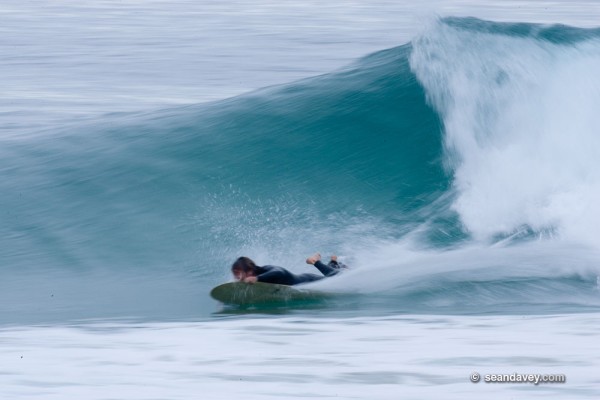
Photo by Sean Davey.
2. When did you start making surfboards for a living and
what sort of boards were these?
When
I started making surfboards, like 1979 to 1983, I was pretty young.
I always wanted to make my own boards, my own types of surfboards. I
think I had a different experience than most. I went backwards in time.
The whole surfboard industry was going one way with the Mark Richards
twin fins, that ripped. There was nothing wrong with those
boards—they’re great—but I could go to Dewey Weber’s surf shop where
there
was a wall of longboards from the 1960s that you could buy, basically
with lunch money. For example, for $21, I bought a Greg Noll balsa pig
and a really nice Hansen Waimea gun for $68. If you could buy a
balsa board for $21, for $9 you could get a regular board. You could
get a really nice Dewey Webber, a Wardy, or a Noll or any other board.
You could walk in with pocket change and walk out with a really nice
1960s longboard.
You could retire on those boards if you kept them.
Well I kinda did up to a point. I absolutely destroyed my surfboards, I
did really lousy ding jobs on them. I sold my balsa board for $500 and
I thought that was at the top of the market. That was way wrong.
Who did you learn your shaping craft from or were you
self-taught?
I was self-taught. I looked at those boards at that time and I said,
“These boards are absolutely glorious. And they work great." When I was
16, I could drive to Malibu, ride these old boards, watch “Endless
Summer" and surf empty Malibu. In the early 1980s, Malibu, San Onofre,
Trestles—these spots were empty, there was nobody there. When I was
tired of riding these boards that I could get dirt cheap, I could still
go to ET surfboards and buy a blank, shape my own board and glass it. I
got to know the old boards well enough and I wanted to create my own
designs. I wanted to pretend the shortboard revolution did not happen
and continue on as if I was back in 1969.
3. Your introduction to paulownia has been fairly well
documented. I
was curious to know after you had that contact with Paul Joske around
1998, what you have learnt about paulownia? For example, I’ve been asked
what is the best paulownia species to make a surfboard?
Well there is Tomentosa, Elongata and Fortunei. The Tomentosa is a more
dense variety and it is good for very thin boards, veneers and things.
But I find the Elongata from Northern New South Wales, that Karl
Seahouse is growing, is absolutely the best. Karl is the guy that
really planted the trees, and carried the ball through the dark ages of
Paulownia, and still does. Now, Karl Seahouse is working for a much
bigger company planting paulownia all over the world for carbon credits.
Tom with a 5' x 20" paulownia bellyboard made for Bob
Green.

Photo courtesy Tom Wegener.
And it is a fast grower too.
Paulownia can grow very fast when the conditions are right and
they are given enough space. I have read that it is the fastest growing
tree in the world.
4. I’ve read about your trip to the Bishop Museum, in
2004, and that
you were wanting to research the very long olo – but what captured your
imagination was the shorter, thinner alaia? What was it that really
caught your eye about those boards?
I just looked at the boards and they were foiled so perfectly. Just so
perfectly. When you see a really good surfboard, you just see it, it
speaks to you, When I looked at those boards I just dropped, “Oh my
god.” Why would you do that? Why is the deck as important as the bottom
of the board. Each board was different from the next with varying rolls
on the top and bottom. It was just so clear to me that they had an
importance, a purpose. When if you look at a tri-fin it has a purpose,
blah blah blah. But you look at those boards and they are infinitely
harder. You could make probably a 100 foam shortboards in the time it
would actually take to make that koa alaia. The ancients by fluke have
left us 13 surfboards and they are all so different. Your mind bends to
see what they were thinking about.
The craftsmanship was pretty incredible.
The more you look at it, the more you buckle. The koa is a very hard
wood and there were knots in the wood grain. The ancient shaper somehow
made perfect curves right through very hard knots in the wood. I would
shiver with my modern tools if I had to do the same. I think if Paul
Joske and other wood board builders went back to see the ancients work,
we would be more impressed than ever.
Bishop Museum
boards (left to right). Photo #1 (left): a kiko'o, three
alaia, and one paipo. Photo #2: a paipo (or perhaps a small alaia,
depending on your definitions of both), a kiko'o, and an olo.
|

|
|
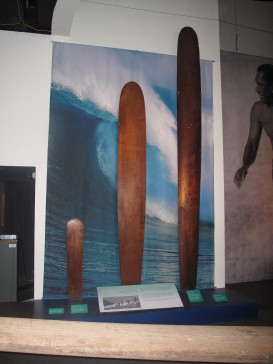
|
Captions by John Clark, photo by Bud Scelsa.
5. The other thing I am interested in is how you got
into
bellyboards. You went from these really long boards to bellyboards. Had
you had much exposure, seen or done bellyboarding before?
I actually had. Where I grew up in California I never liked crowds. I
can’t actually handle a pecking order.
I know what you mean.
I lived in many areas of Southern California and there always seemed to
be a few really shallow reef breaks. The breaks really went dry like
Hospitals in La Jolla. I always like surfing these waves because there
was no crowd, but it took a while to learn how to do it. The boogie
boards seemed to me to be too slow, but then I never had a new stiff
one. I liked the old fibreglassed body boards from the 1960s. But there
was another problem with the buoyant boards. I would get sucked onto
the reef with them. Then I went to the basic McDonald’s tray, or low
volume board, and found that was the best. When the wave closed out I
could go through the wave to safety and not get dragged across the
rocks. It was like body surfing but going really fast.
So you had a background in fairly neutral buoyancy
bellyboards back in those days?
Oh yeah, absolutely. It was kinda out of necessity, I guess, but I love
neutral buoyancy bellyboards.
That explains a bit. Were they fibreglass boards you
were making or wood boards?
Back then, in the 1980s you never had to buy anything because there was
so much good stuff just lying around. I had people literally throwing
stuff into my yard because they knew I was really into the old surfing
equipment. Like I’d wake up in the morning and go down by the driveway
to get the mail at my parent’s house and there would be 1 or 2 old
banged up boards there.
So you’d make a bellyboard out of the old longboards?
Well actually, I was given two nice 1960's body boards.
Ok, that would be a bonus.
It was crazy. I mostly rode a Bing belly board that had a fin on it. It
was in mint condition, but soon broke the fin off on the shallow reef.
When I paddled back out on it, it rode better without the fin. That was
it. It was a monumental moment for me when I realised that this
bellyboard rode better without a fin.
"1963 Bing
Bellyboard, 2'' balsa stringer"
|

|
|
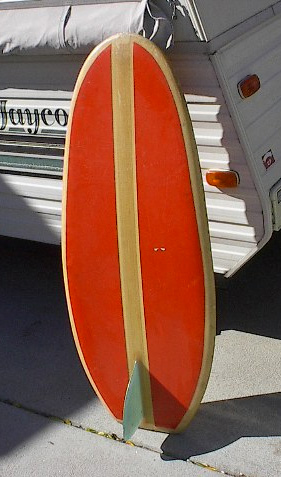
|
Photo from: http://www.classicbingsurfboards.com/earlybings5964.html
And you don’t necessarily need a fin.
You don’t need a fin at all. A fin doesn’t do anything for you if you
are going prone.
A finless Bing
bellyboard (decal is on the bottom side, flowered deck is topside)
|

|
|
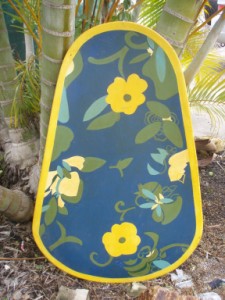
|
|
|
|
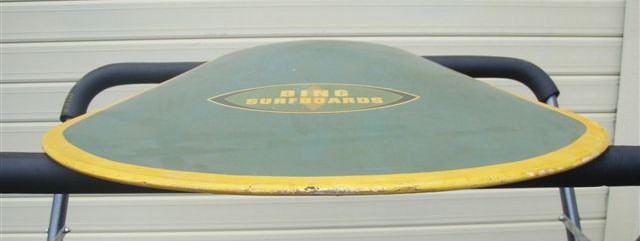 |
|
|
|
 |
|
|
|
 |
Photos courtesy Carl Tanner.
6. That leads onto the next question I was going to ask.
You’ve
described flex and a hard rail edge as making the standup alaias work.
How important are these design principles when riding an alaia or a
bellyboard prone?
At this point I always put concaves in the bottom of all my alaias, But
I don’t actually think it is all that important for short alaias. Mike
Stewart found he liked the convex bottom, so I don't want to second
guess him. I like the little bit of lift I get from the concave. What
is important is the flex. Bending the board into the face of the wave
makes the board faster and easier to control. I like the square rails
like the boards I saw in the Bishop museum. Round rails really slow the
alaia down.
I was going to ask you about flat bottoms to produce
speed. Where do you put the concaves, near the tail or the nose?
The boards in three sections. The back 2/3’s is concave and the front
1/3 is convex.
That sounds very much like a fibrelass board that
Larry Goddard from Hawaii described to me. It has the same bottom
configuration.
Yeah, it’s the basic, there’s nothing new about the design. Some guy
from Australia went to Hawaii early on and brought back four boards,
and two of them had concaves. Two of the boards survived, one board
disappeared and one of the boards with a concave is in somebody’s
mantelpiece, somebody’s fireplace.
I think Beaurepaire was the guy. The board was down in
Victoria somewhere.
Yeah that’s it.
7. The other thing that intrigues me is that a lot of
people will
know about your paulownia alaia boards, but that not many people will
have heard of your experiments with plywood bellyboards. How do they
differ in design and how do they perform?
Plywood is OK. The ply bodyboards found all over Europe are actually
super fun to ride!!! Also, with the ply you can get the nose to bend
up. I found this to be a very comfortable feel in the water and you get
reverse rocker very easily by just pushing down on the nose. The more
reverse rocker gives you more speed. The scooped up nose was not for
looks, it is a real design innovation that has been lost with modern
surfing.
Tom Wegener and John Isaac (UK) at the 2009 'Wood
world bellyboard championship" [see Note 1]
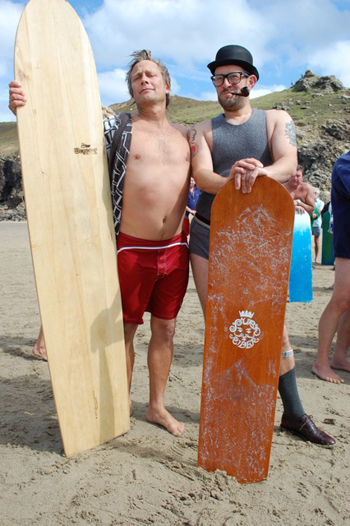
Photo by: Marge Wegener.
There is a long history of ply bellyboards.
They’re good really. What I really want to say is you can’t stand
on a plywood board. It doesn’t have what it takes to stand up on it.
But for a bellyboard, ply is good. I think the paulownia is better but
the ply is very good.
Finley Wegener, "world champion"
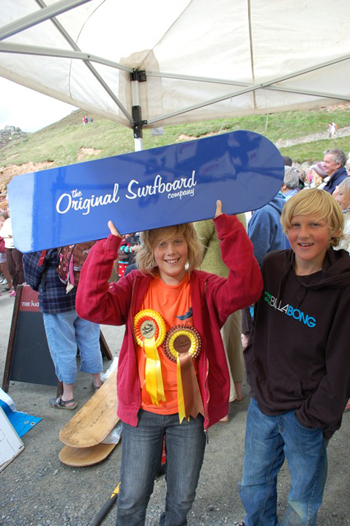
Photo Marge Wegener.
Do you think they ride differently?
The paulownia is lighter so you get a little bit more flotation and you
can shape a paulownia board, so you put in a little bit of concave in
it. And I really think that either a little bit of convex curve or a
concave makes the board alive when you are angling across a wave. The
flat bottom is more for going straight toward shore. That’s what they
did in UK, Spain and stuff for 50 years. They’d stand in the water and
head for shore, but when you start riding in the tube and start angling
a bit, stall and work the board, a little bit of curve in the bottom
really starts to suck the board up the face. I think the plywood is
great and it is better than foam. No doubt about it. If you were really
going to start to surf the board in the curl and angling across waves
then a little bit of roll doesn’t hurt. Then the paulownia gives you
the opportunity to change the shape of the bottom while ply is flat top
and bottom.
Are the ply shapes the same as the paulownia boards or
are they based on the UK designs?
I base mine on the UK designs. I just love them. I think they go great.
I surf the UK design quite a bit and they are really good until you see
a really good section and want to pull into the tube and actually make
it. Then you go back to the ancient Hawaiian designs. You go right back
to the Bishop Museum. You have a roll on the bottom, a rail that is 3mm
thick, roll on the deck and you have this board that will flex into the
wave. Again, the ply is good, but then if you want the real deal, if
you want the ultimate surfboard you go back to the BCM. You look at it,
study it, study the ancient boards and you go, “Wow, they knew what was
going on.”
8. I see the difference in the style of surfing that
makes it
pretty clear. The other thing I was going to ask you was that you’d
mentioned that you had been amazed by the bodyboard’s capacity to
produce reverse rocker and Tom Morey’s vacuum rail. Do think those
concepts have any application to wooden boards?
They do. You know I’ve struggled. My hero is George Greenough. I got
real lucky that I know him pretty well and I call him and talk to him.
I’d like to do an article, you should do an article on him. I’m sure
that he has the same torments that I do, that is reverse rocker goes
faster. There is no doubt about it. Reverse rocker goes so much faster,
it’s mental. My team rider, Mat, I was videoing him and he took off on
a wave and the board is broken in half, but not totally in half and he
had reverse rocker in it and I’ve never seen anything that moves across
a wave like that. My god. You take a board that is broken, not totally
broken, but creased and you have that exaggerated reverse rocker. Oh,
does it move.
What about the vacuum rail. I’ve heard people say the
hard rail on
boogie boards was a stroke of genius. The vacuum rail, how does that
apply?
There’s a story about this. I’ve actually researched this. When I was
in California one and a half years ago I went to Tom Morey because I
had made my first Tunas. I said, “How did you invent the vacuum rail?”
This is what he told me. He said, “When I needed this board to hold
into a wave I was surfing in Kauai at the time, there was a little
wave, a right and a left.” He was surfing this little wave and he said
he wanted a soft board that would ride this wave because he couldn’t
actually get foam soft enough back in the late-1960s. He couldn’t get
any materials other than wood on the Big Island of Hawaii, so he
started fooling around with these foams and he made a boogie board
kinda shape and he was riding it upside down. He didn’t say this, but
George Greenough was supposedly there and said, “Tom turn the board
upside down, you have it upside down” and it actually worked better the
other way. I heard this story from a good friend of George's. But Tom
Morey told me the story that he said that he looked at that rail and
said, “I want to make a Vee bottom like a Hot Curl" because he was
actually around when the Hot Curls came into fashion. He said, “you
have the flat bottom boards and you put a Hot Curl tail on it and they
really hold into a wave. So he thought, I’ll just put two Hot Curl’s on
a boogie board. I’ll just put a Hot Curl bottom on that rail and on
that rail and it will hold,” and bingo. It held. But his idea for a
vacuum rail is a Hot Curl. That’s what he told me anyway. [For more information on the vaccum rail see Note 2.]
They’re both interesting stories. I like the George
Greenough story.
George is the man. He has an understanding of things, that is, just
well, it’s amazing.
9. We’ve been talking about design. What also interested
me was a
comment that you made that riding a prone board well is very different
from riding at a beginner level. Most people dismiss prone riding
because they just see someone lying down. When it comes to big waves or
hollow waves there is a lot of technique involved?
Oh yeah.
What skills or techniques from your perspective are
involved in riding prone at that more advanced level?
First, Mike Stewart and the really good body boarders, they have got
Pipeline sewn up. As far as I am concerned Pipeline was meant to be
ridden on a bodyboard. They surf it better than any standup guy could,
they get deeper in the tube, often in giant waves. For the rest of us,
who don’t surf Pipeline on a regular basis, who live in regular
community centres, like where all of us live, Los Angeles, here, Perth,
Biarittz in France, and the rest of the world, we surf small waves all
of the time. I think that on a 5’5” thin bellyboard, if you ride these
little waves, all of a sudden the magic of it comes, a good prone rider
can make a section and kinda come off these little sections, it is
beautiful but it is not easy to do. It’s bending the board so it gets
as much speed as it can. What I know now is that the speed you get from
altering the rocker in your board is phenomenal. Just the incredible
difference in speed you get. This is what George Greenough is saying all the
time. Greenough. He’s been saying this forever. You have to get
reverse rocker. That’s why he bellyboards, so he gets that feeling of
speed. Once you do get that feeling of speed everything else is dead.
You come into a little section and it can be only waist high, it can be
onshore slop, you pull up on that board and get reverse rocker and you
get that speed. It’s a gas. The people that can do that are beautiful
to watch. But I just don’t think anybody has ever seen it. Me and my
little micro crew here I force them to paddle out to surf the waves and
then watch it, it’s absolutely glorious. Nobody’s ever seen it, I don’t
think anybody has ever seen the way to bellyboard a wave properly. It’s
really good. The way we have evolved surfing is that we haven’t
actually seen a huge percentage of surfing. Nobody has visually seen a
person on a toothpick, ride a proper Waikiki board that was popular for
70 years, never seen anyone ride a proper paipo. These boards that
nobody has ever seen before and they are huge parts of surfing history.
Mike Stewart and Wegener quiver
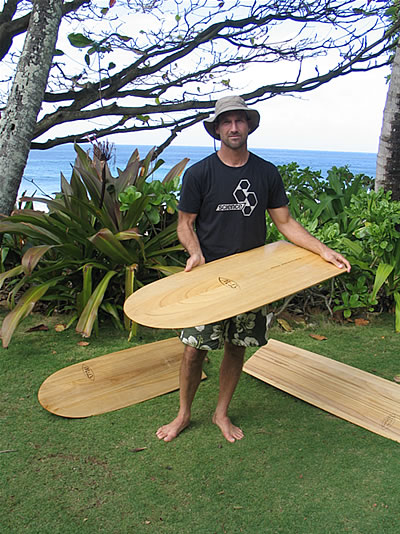
Photo courtesy Tom Wegener.
You’ve touched on a raw nerve. I’ve been sort of
trying to convince
people in Hawaii to photograph people or take video of people like John
Galera, Larry Goddard who rode Makaha in the 1960s/1970s, and Sean Ross.
There’s just no footage of any of these guys.
If you didn’t photograph it, it didn’t exist. It never happened.
10. I think you have answered my next question, "What was
the attraction of riding prone?" Speed seems to be a common denominator.
Definitely, in my experience. Prone surfing is far faster, absolutely
faster than standup surfing, we cannot go faster. You’re just an
absolute missile because you get reverse rocker. When you are standing
on a surfboard you are stuck with that rocker, that is all you are
going to do. With the vacuum rail, you don’t have to go down the wave,
you can hang in the lip--you can be up in the lip the whole time.
The vacuum rail of Tom's latest project.

Photo courtesy Tom Wegener.
That’s where the speed is.
It’s all happening up there. That’s the thing. With a bellyboard you
can stay in the curl, at the top of the lip, way up there. Whereas as
soon as you have a fin on your board you have to point the nose toward
shore. Why are you going that way when you should be going, that way.
With the toothpicks you don’t have to drop down the face of the wave.
You’re already here at the top of the swell, driving across the wave
and there’s no drag and you don’t have to drop down the wave to get
seed again, as you already have as much speed as you can possibly can.
11. Of all the waves that you have ridden are there any
waves or surfs that have really stood out when you have ridden prone?
Coming from the Noosa points are incredible. From Nationals, when you
try to make it through Johnsons, there is a very long section there.
It’s probably 70 metres and it is fast. I’ve never actually seen anyone
really make it except on finless surfboards. When you are on an alaia,
this is five years ago when I was bellyboarding a 7’ alaia. I said, "Why
am I am going to standup when I can bellyboard it?" When this wave was
totally clean still I preferred to bellyboard because it was actually
more fun to bellyboard, lying down on an alaia. The whole standup thing
is a little weird because bellyboarding on an alaia is the best. Coming
through that section at such a speed that if somebody dropped in on me
I would clip them and would just go past them. There was nothing there.
The speed was so much when you fell of your eyes get peeled back, your
mouth gets filled up with water. You hurt when you fall off at that
speed. But if somebody drops in on you they don’t even exist, you pass
them. The speed on an oiled board, because I’ve been screwing around
with these glassed epoxy boards, I’m making them to ride like an alaia,
the only big difference between the boards now is the oiled surface, is
10-15% faster, hands down. A properly oiled surface that is the only
difference between the boards, the drag factor, at least 10—15% faster
than a glassed surface.
Tom Carroll
'rehabilitating'
|
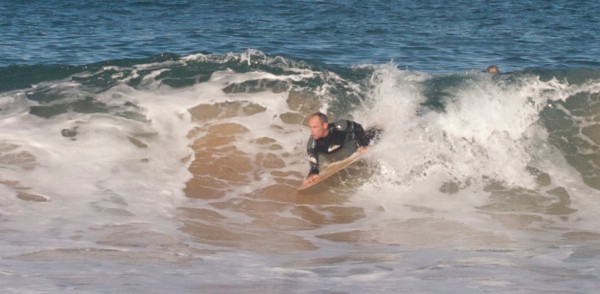
|
|
|
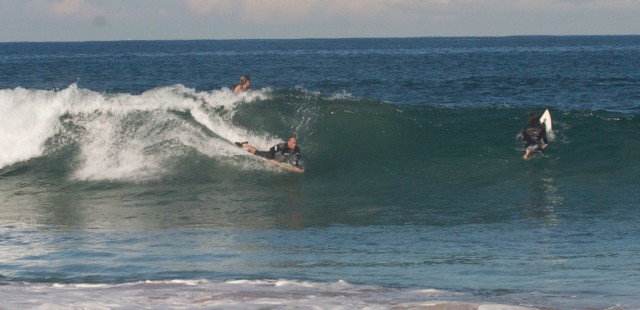 |
|
|
Photo courtesy Tom Wegener.
Are you still sticking with same oil formula?
When you put the vinegar, linseed with the gum turpentine, you just keep
oiling it with linseed oil. That’s the fastest. I don’t think linseed
oil is magic, I think any oil would work. The combination of oil with
salt water just gives you that release that you don’t get with foam.
I’ve used tung oil--it’s like a natural varnish. But
it’s a bit expensive.
People say, “Tom, why don’t you use tung oil?” You can go to any
place and use linseed oil. It’s cheap. You could use olive oil. It’s
all oil, from my impression anyway. They’re all about he same,
providing your board isn’t dried out and your board has oil on it. Go
for it. I don’t think it is that big of a difference.
12. Are there any new directions or ideas that you are
thinking of
in relation to prone boards? Reading your story, every few years you
seem to take a different turn. Is there anywhere you think prone boards
could be heading?.
No, I think we just need to figure out what
the ancient
Hawaiians were doing. We just don’t really know where prone boards have
been.
So it’s rediscovery more than new directions?
I think it is rediscovery. Almost nobody rides prone and I can’t
believe it, almost nobody rides prone. I’m at the point and how painful
is it, when you see the perfect tube and some wanker is standing in
front of it. You are like, “Why are you there, how come you’re not
there, how you come you’re not in the tube? My god, what are you doing?”
It’s harder work and you don’t like pecking orders,
but we are at
the bottom of the pecking order except under certain special conditions.
It’s stupid. We are all human beings. When I paddle out and I’m on my
prone bodyboard and somebody drops in because they think I am a kook,
you know what I do, which is horrible, I paddle in and I get my
16-footer and take every set wave. It’s real bad. I look at that same
people and say, “you just dropped in on me and I’m going to take every
wave now." It’s sad. In my mind, the shortboard revolution and you can
quote me on this, is that the shortboard revolution is supposed to be
this great enlightenment, and the only thing that the shortboard
revolution has taught us is that the guy on the biggest board gets the next set
wave. It’s a very weak revolution.
13. What have you learned from George Greenough and how
do these ideas apply to prone boards?
He’s so good at surfing. He’s truly a guru in the surfing world. What
he did speaks louder than his words obviously. When he had his camera
on the back of his board, when Lennox was absolutely pumping. It was
big, big Lennox. He was telling me how big Lennox was that day when he shot
that footage. He took off on his finned board and it actually was too
big to properly ride a finned surfboard. So he paddled out at stupidly,
ridiculous Lennox, with a half inflated mat and the mat rode better. That
actually was the proper board for the day. To me that’s hard thing to
sink in.
It would take some courage.
Oh God. I’ve personally never seen Lennox like that but I’ve seen
glimpses of that hollowness. That serious strength thrown at you. To
think he’d say, “yeah, a bellyboard. I’m going to ride a half inflated
mat.” I don’t think anybody in the surfing could even come to terms
with that, to do what manoeuvre he did, he’s so far ahead, that even
now nobody could come to terms with that manoeuvre that he did.
There’s a real pioneering spirit there.
He’s courageous. He’s a little guy, he’s not a big strong guy. A small
strong-willed guy. He’s no Laird Hamilton.
14. Any final thing you’d like to say?
I’d like to say something about David
Rastovich. I’ve
spent a bit of time with him. Sometimes I get a jaded toward
professional surfers and all that, but Rasta has gone through all the
hoops to get him where he is today. We were talking about the ancient
Hawaiians and this is right after he had come back from Hawaii and he
surfed Waimea Bay on the alaia. He was kinda saying, speed is
everything and he said “the ancient people before there were cars, you
had to ride a horse to go fast. There was really no other way to go
fast other than surfing. You can slide down a hill or you can surf.
But, there is no other way to go fast.” I just thought that was so
insightful. The other vast majority of our history is without cars,
without going fast. That’s where the sensation of speed comes from.
An interesting observation.
David Rastovich is the real deal. He body surfs and prone rides better
than anybody. You just don’t ever see him. He is the king.
You should try to get some footage.
I want to, everybody is trying to.
You just don’t see paipo footage anymore.
I heard an interesting story about when Duke Kahanamoku came to ride
those waves, he wanted to surf at Manly but couldn’t because there were
too many bellyboarders in the water so he couldn’t surf there, so he
had to go to Freshwater. I was looking at the toothpicks at the Manly surf club and I said I had
to make two surfboards in the future. One a paulownia bellyboard and
the other a toothpick. You’d cover the entire range of surfing better
than anything else with those two surfboards. One is 16 foot long and one
is 5 foot long. That’s it, you don’t need anything else. If you had the wood
you could make them for peanuts and they would last you for your entire
life. One more story. When I went on the King Island trip, on the finless
thing, with Derek Hynd. Tom Carroll and everybody was there and I asked
over dinner, "Which of you guys ride boogie boards?"
You would have got the death stare.
I got the death stare. Derek said, “Oh my god, an oversight.” It was so
black and white. What are you talking about finless surfing without a
boogie board being here.
I’ve seen Warren Pfeiffers’s footage and that was some of the best
surfing of the whole trip. Warren is the man. Jack McCoy and Derek were
giving him so much cred. What he does is not easy. It looks easy, you
go and do it, it’s not easy. You take the average surfer. I walk down
the beach with the alaia and everyone is looking at me funny. I say,
“I’m going to get to my feet and ride this board across the waves and
have a really good time. I would bet my entire house and my mortage,
that you could not do it even in an hour. Even a hot little grommet,
you couldn’t do it."
There’s a lot to it. I’ve make surfboards for a few
people, I’ve even made boards for people who can’t stand up and they know
they can’t stand up anywhere. But they want to put a fin on because they
want to look normal. I say, “Why do you want to look normal? I can make
you a nice board that you can ride prone just fine.”
Of all the ages of surfing, 1985, when longboarding was at it’s lowest
ebb, there were seven of us, we could go somewhere and surf these
insanely perfect waves and there was nobody out. That’s where prone
surfing is right now. We can go to places great for bodyboarding and
there is nobody there. It’s high tide, the points are going to be good
at low tide. So there are a 1,000 people waiting for low tide and right
along the rocks there is this little right hander that’s breaking in
about 2 inches of water and it smokes for abort 100 metres. I’m on my
bellyboard and get about 40 waves and I go in as the tide is going out
and I’m going home.
Tom tubed at King Isand

Photo by Sean Davey.
|
Note 1: For more information, see the World Bellyboard Championships in MyPaipoBoards.
Note 2: See the article describing another application of
the vacuum rail in the following article: Wegener, Tom. (2010, month). To Catch A Tuna. Pacific Longboard Magazine, 14(2), 73. Tom Wegener's long and winding fin-free journey from paulownia plank to the polystyrene Tuna.
Other Items of interest:
- Tom's webpage, Tom Wegener Surfboards
- Videos:
- Wegener
Surfboards: Alaias. By Tom & Jon Wegener
-
Tom
Wegener Surfboards Promo: One. This is a promo piece made a few years back by Nathan Oldfield for Tom Wegener Surfboards. Music by Mike McCarthy.
- Tom
Wegener Surfboards Promo: Two. This is a promo piece made recently by Nathan Oldfield for Tom Wegener Surfboards. Music by Purplene & Mike McCarthy.
- Wood is Good (4 parts):
Tom Wegener at Patagonia Surf Shop Cardiff. On Saturday, October 11,
2009, after the Sacred Craft Surfboard Expo, surfboard shaper Tom
Wegener gave an evening presentation at Patagonia's Cardiff Surf Shop.
Tom spoke about shaping surfboards from Paulownia wood, specifically
classic single fin longboards, hollow surfboards and the traditional
Hawaiian alaia design which Tom and his friends help reintroduce to the
surfing world. See the videos: Part 1 | Part 2 | Part 3 | Part 4
|
|